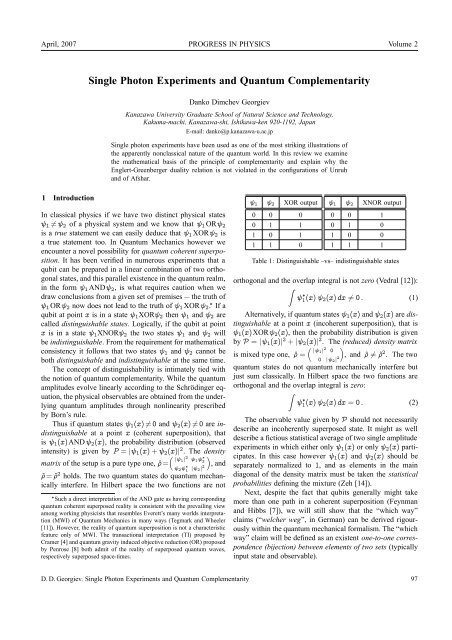ISSUE 2007 VOLUME 2 - The World of Mathematical Equations
ISSUE 2007 VOLUME 2 - The World of Mathematical Equations
ISSUE 2007 VOLUME 2 - The World of Mathematical Equations
Create successful ePaper yourself
Turn your PDF publications into a flip-book with our unique Google optimized e-Paper software.
April, <strong>2007</strong> PROGRESS IN PHYSICS Volume 2<br />
1 Introduction<br />
Single Photon Experiments and Quantum Complementarity<br />
Danko Dimchev Georgiev<br />
Kanazawa University Graduate School <strong>of</strong> Natural Science and Technology,<br />
Kakuma-machi, Kanazawa-shi, Ishikawa-ken 920-1192, Japan<br />
E-mail: danko@p.kanazawa-u.ac.jp<br />
Single photon experiments have been used as one <strong>of</strong> the most striking illustrations <strong>of</strong><br />
the apparently nonclassical nature <strong>of</strong> the quantum world. In this review we examine<br />
the mathematical basis <strong>of</strong> the principle <strong>of</strong> complementarity and explain why the<br />
Englert-Greenberger duality relation is not violated in the configurations <strong>of</strong> Unruh<br />
and <strong>of</strong> Afshar.<br />
In classical physics if we have two distinct physical states<br />
ψ1 �= ψ2 <strong>of</strong> a physical system and we know that ψ1 ORψ2<br />
is a true statement we can easily deduce that ψ1 XORψ2 is<br />
a true statement too. In Quantum Mechanics however we<br />
encounter a novel possibility for quantum coherent superposition.<br />
It has been verified in numerous experiments that a<br />
qubit can be prepared in a linear combination <strong>of</strong> two orthogonal<br />
states, and this parallel existence in the quantum realm,<br />
in the form ψ1 ANDψ2, is what requires caution when we<br />
draw conclusions from a given set <strong>of</strong> premises — the truth <strong>of</strong><br />
ψ1 ORψ2 now does not lead to the truth <strong>of</strong> ψ1 XORψ2. ∗ If a<br />
qubit at point x is in a state ψ1XORψ2 then ψ1 and ψ2 are<br />
called distinguishable states. Logically, if the qubit at point<br />
x is in a state ψ1XNORψ2 the two states ψ1 and ψ2 will<br />
be indistinguishable. From the requirement for mathematical<br />
consistency it follows that two states ψ1 and ψ2 cannot be<br />
both distinguishable and indistinguishable at the same time.<br />
<strong>The</strong> concept <strong>of</strong> distinguishability is intimately tied with<br />
the notion <strong>of</strong> quantum complementarity. While the quantum<br />
amplitudes evolve linearly according to the Schrödinger equation,<br />
the physical observables are obtained from the underlying<br />
quantum amplitudes through nonlinearity prescribed<br />
by Born’s rule.<br />
Thus if quantum states ψ1(x) �= 0 and ψ2(x) �= 0 are indistinguishable<br />
at a point x (coherent superposition), that<br />
is ψ1(x)AND ψ2(x), the probability distribution (observed<br />
intensity) is given by P = |ψ1(x) + ψ2(x)| 2 . <strong>The</strong> density<br />
matrix <strong>of</strong> the setup is a pure type one, ˆρ =<br />
�<br />
|ψ1| 2 ψ1ψ ∗<br />
2<br />
ψ2ψ ∗<br />
1<br />
2<br />
|ψ2|<br />
�<br />
, and<br />
ˆρ = ˆρ 2 holds. <strong>The</strong> two quantum states do quantum mechanically<br />
interfere. In Hilbert space the two functions are not<br />
∗ Such a direct interpretation <strong>of</strong> the AND gate as having corresponding<br />
quantum coherent superposed reality is consistent with the prevailing view<br />
among working physicists that resembles Everett’s many worlds interpretation<br />
(MWI) <strong>of</strong> Quantum Mechanics in many ways (Tegmark and Wheeler<br />
[11]). However, the reality <strong>of</strong> quantum superposition is not a characteristic<br />
feature only <strong>of</strong> MWI. <strong>The</strong> transactional interpretation (TI) proposed by<br />
Cramer [4] and quantum gravity induced objective reduction (OR) proposed<br />
by Penrose [8] both admit <strong>of</strong> the reality <strong>of</strong> superposed quantum waves,<br />
respectively superposed space-times.<br />
ψ1 ψ2 XOR output<br />
0 0 0<br />
0 1 1<br />
1 0 1<br />
1 1 0<br />
ψ1 ψ2 XNOR output<br />
0 0 1<br />
0 1 0<br />
1 0 0<br />
1 1 1<br />
Table 1: Distinguishable –vs– indistinguishable states<br />
orthogonal and the overlap integral is not zero (Vedral [12]):<br />
�<br />
ψ ∗ 1(x) ψ2(x) dx �= 0 . (1)<br />
Alternatively, if quantum states ψ1(x) and ψ2(x) are distinguishable<br />
at a point x (incoherent superposition), that is<br />
ψ1(x)XORψ2(x), then the probability distribution is given<br />
by P = |ψ1(x)| 2 + |ψ2(x)| 2 . <strong>The</strong> (reduced) density matrix<br />
�<br />
|ψ1| 2 �<br />
0<br />
is mixed type one, ˆρ =<br />
0 |ψ2| 2<br />
, and ˆρ �= ˆρ 2 . <strong>The</strong> two<br />
quantum states do not quantum mechanically interfere but<br />
just sum classically. In Hilbert space the two functions are<br />
orthogonal and the overlap integral is zero:<br />
�<br />
ψ ∗ 1(x) ψ2(x) dx = 0 . (2)<br />
<strong>The</strong> observable value given by P should not necessarily<br />
describe an incoherently superposed state. It might as well<br />
describe a fictious statistical average <strong>of</strong> two single amplitude<br />
experiments in which either only ψ1(x) or only ψ2(x) participates.<br />
In this case however ψ1(x) and ψ2(x) should be<br />
separately normalized to 1, and as elements in the main<br />
diagonal <strong>of</strong> the density matrix must be taken the statistical<br />
probabilities defining the mixture (Zeh [14]).<br />
Next, despite the fact that qubits generally might take<br />
more than one path in a coherent superposition (Feynman<br />
and Hibbs [7]), we will still show that the “which way”<br />
claims (“welcher weg”, in German) can be derived rigourously<br />
within the quantum mechanical formalism. <strong>The</strong> “which<br />
way” claim will be defined as an existent one-to-one correspondence<br />
(bijection) between elements <strong>of</strong> two sets (typically<br />
input state and observable).<br />
D. D. Georgiev. Single Photon Experiments and Quantum Complementarity 97

















